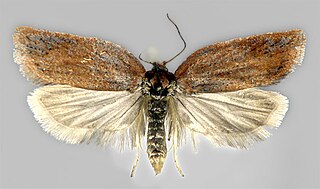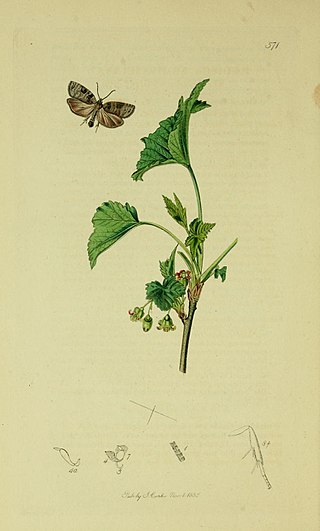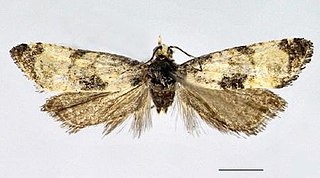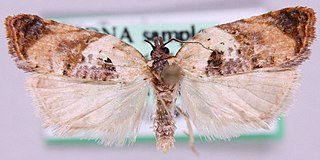
Cochylis nana is a moth of the family Tortricidae. It was described by Adrian Hardy Haworth in 1811. It is found in Europe, Amur Oblast of Russia and Nova Scotia in Canada.

Archips xylosteana, the variegated golden tortrix or brown oak tortrix, is a moth of the family Tortricidae.

Aleimma loeflingiana is a moth of the family Tortricidae. It is found in Europe and the Near East.

Bactra lancealana is a moth of the family Tortricidae found in Europe. The moth has a wingspan of 11–20 mm. The forewings are pale ochreous or ochreous- brownish, costa strigulated with darker ochreous or dark fuscous; a spot in disc at 1/3 and an angular mark beyond middle dark fuscous, often obsolete, sometimes forming a more or less complete dark median streak from base to apex; central fascia sometimes indicated on costa. Hindwings are grey. The larva is greenish or whitish-fleshcolour; head and plate of 2 black. It is very similar to Bactra furfurana.

Celypha cespitana is a moth of the family Tortricidae. It is found in the Palearctic realm, from western Europe to the Ural Mountains, Transcaucasia, Asia Minor, the Near East, Iran, Russia, north-eastern China (Manchuria), Korea and Japan. It is also found in the Nearctic realm.

Acleris rhombana, the rhomboid tortrix, is a moth of the family Tortricidae. It is found in the Palearctic realm, from Europe to the Caucasus, Armenia, and Turkmenistan.

Bactra is a genus of moths belonging to the subfamily Olethreutinae of the family Tortricidae.

Acleris rufana is a moth of the family Tortricidae. It is found from northern, central and south-western Europe through southern Siberia to the Russian Far East and Japan.

Apotomis semifasciana, the short-barred grey marble, is a moth of the family Tortricidae. It was first described by the English entomologist Adrian Hardy Haworth in 1811.

Cochylis hybridella is a moth species of the family Tortricidae. It is found in most of Europe, the Near East, China, Japan, Korea and Russia.

Apotomis betuletana is a moth of the family Tortricidae. It is found in most of Europe. It is also found in the eastern part of the Palearctic realm. The habitat consists of woods and woodland margins where birch occurs.

Archips crataegana, the brown oak tortrix, is a moth of the family Tortricidae. It is found in most of Europe east to Japan.

Cochylichroa atricapitana, the black-headed conch, is a moth of the family Tortricidae. It is found in China (Xinjiang) and the eastern Palearctic and most of Europe.

Cochylis dubitana, the little conch, is a moth of the family Tortricidae. It is found in China (Heilongjiang) and most of Europe. and the Caucasus. It is also found in North America, where it has been recorded from Colorado, Maine, Ontario and Washington.

Acleris schalleriana, the viburnum button or Schaller's acleris moth, is a moth of the family Tortricidae. It was described by Carl Linnaeus in 1761. It is found in most of Europe. It is also found in North America. Acleris viburnana is a possible synonym that refers to the North American populations.

Cochylis pallidana, the sheep's-bit conch, is a moth of the family Tortricidae. It was described by Zeller in 1847.

Cnephasia longana, the omnivorous leaftier moth, long-winged shade or strawberry fruitworm, is a moth of the family Tortricidae. It was described by Adrian Hardy Haworth in 1811. It is native to western Europe. It is an introduced species in western North America. The species has also been reported from north-western Africa and Asia. The habitat consists of downland and rough ground.

Cochylimorpha straminea, the straw conch, is a species of moth of the family Tortricidae. It is found in most of Europe, Morocco, Algeria, Tunisia, Asia Minor, the Palestinian territories, Iraq, Syria, Armenia, Transcaspia, Turkmenistan and Iran.

Acleris permutana is a species of moth of the family Tortricidae. It is found in Ireland, Great Britain, Portugal, Spain, France, Belgium, the Netherlands, Germany, Denmark, Sweden, Austria, Italy, the Czech Republic, Slovakia, Slovenia, Croatia, Hungary, Romania, North Macedonia and Russia. The habitat consists of coastal sandhills and limestone.

Cnephasia conspersana is a species of moth of the family Tortricidae. It is found in Ireland, Great Britain, France, Italy, Portugal, Spain and North Africa. The habitat consists of coastal chalk downlands and heathlands.



















